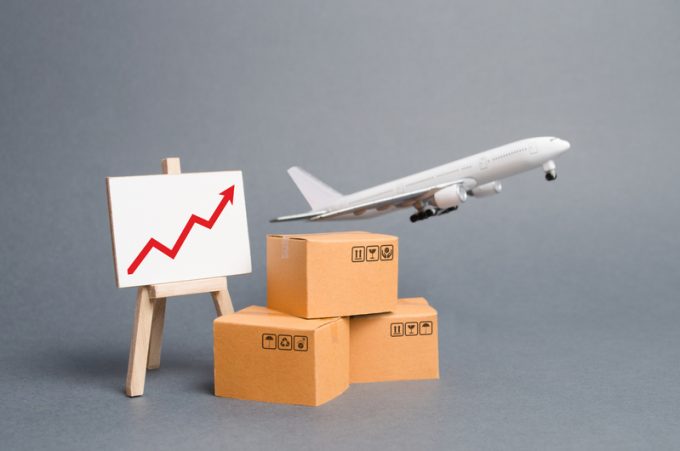No summer siesta for airfreight
Traditionally, air cargo spot rates tend to decline or remain flat at best during H1, ...

In 2021, as the world began to recover from the Covid-19 pandemic, air cargo traffic boomed, growing nearly 19% that year over depressed year 2020 traffic volumes, bolstered by both e-commerce and severe disruption in containership-supported supply chains.
However, year-on-year air cargo traffic (measured in tonnes enplaned, multiplied by km flown) began to contract in March 2022, due to several factors, including the Russia-Ukraine war, inflation, and China’s “zero-Covid” policy.
Full-year 2022 air cargo traffic fell 8.1%, and continued to fall until August 2023, when IATA announced that traffic grew by a paltry 1.5% over August 2022 levels, with the world’s two major regional markets in positive territory (see chart below).
IATA recently reported that global air cargo traffic expanded in October this year, albeit tepidly at 3.8%, for the third straight month , compared with the same month one year prior.
Curiously, air trade data collected by national and pan-national trade authorities does not align at all with the IATA-reported air cargo traffic uptick recorded in the August-October timeframe. One industry research analyst estimated that world international air trade (based on national customs statistics) fell 8% in August 2023.
So what might be the cause of this discrepancy between these two different data sources on air cargo activity?
Incredible as it may seem, both statistics are likely correct, with the difference lying in semantics. IATA measures traffic, whereas national customs authorities measure trade.
IATA strives to measure traffic for all types of air cargo, including general freight, traditional express (small parcel and documents) and (this is increasingly important) e-commerce. Trade data, however, measures “hundredweight” scale shipments of international merchandise trade by commodity code and, it should be noted, does not capture traditional express shipments or e-commerce movements due to reporting thresholds. For example, small parcel and document (eg, “traditional express”) traffic, the “core product” of the major integrators like DHL, FedEx, and UPS and, has by and large, never been captured directly in trade statistics for the past four decades.
However, the rise of cross-border e-commerce, particularly during the Covid and post-Covid eras, has created another sub-set of air freight shipments which are not documented in most national trade statistics. Most cross-border e-commerce moves by air, and this sub segment of air cargo may account for up to 20% of global traffic volumes.
China is the most important source of cross-border e-commerce purchases worldwide, and Alibaba’s International Digital Commerce Group (AIDC) runs the most important cross-border platforms. In its most recent quarterly filing, Alibaba indicated that orders grew 28% year on year. Cainiao, Alibaba’s logistics arm, states in its recent A1 filing to the Hong Kong Stock Exchange that it moved 1.5bn international packages in the financial year ended March 2023 (compared with 1.7bn and 1.4bn, respectively, in the two preceding years). That is more than the combined international parcel volumes moved by DHL, FedEx and UPS. These three companies collectively move about 1bn international packages a year.
In very close alignment with the IATA reported air cargo traffic data, Chinese international air cargo traffic has picked up substantially since July 2023, with growth particularly strong in August, September and October. The chart below shows monthly PRC international tonnage since January 2015.
However, air import trade statistics for Europe and the US do not show an increase during this timeframe. Not surprisingly, value-reporting thresholds imply that any increase in e-commerce air import traffic is unlikely to be captured in trade data. Reporting thresholds for the European Union are €1,000, or 1,000kg, and for the US, it is $2,500 for exports and $2,000 for imports. Consequently, we may be witnessing an “almost covert” nascent recovery in air trade via e-commerce.
According to IATA, the preponderance of air cargo strength has been seen on the Europe-East Asia air tradelane, with Middle East-domiciled airlines being the primary beneficiary of the scheduled cross-border e-commerce pick-up. But charter freighter flights have also accelerated, with one large widebody freighter operator reporting it operated more than 10 Asia-to-Europe ad-hoc flights last month, whereas they flew none in November 2022.
While it is heartening to see a sustained, albeit-weak, recovery in air cargo traffic, it should be noted that industrial activity, which remains depressed, is still the primary driver of air trade. Until a recovery in the manufacturing sector begins to appear, the case for “guarded optimism” for the air cargo industry remains.
For additional insights on the current e-commerce surge in air cargo, please visit our website at www.tradedataservice.com
Comment on this article